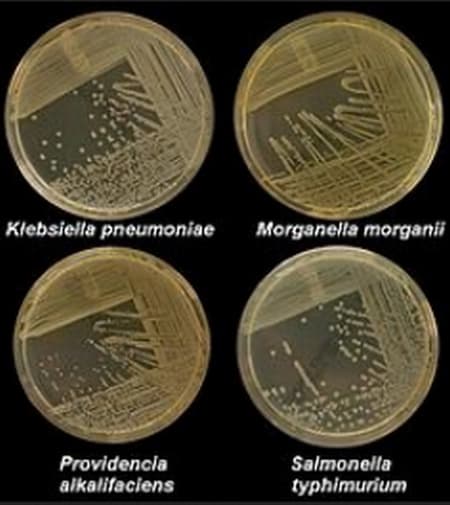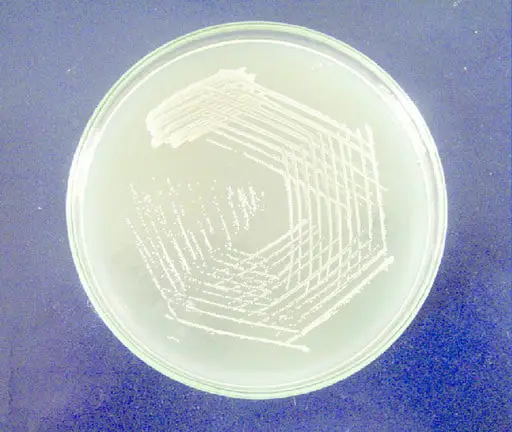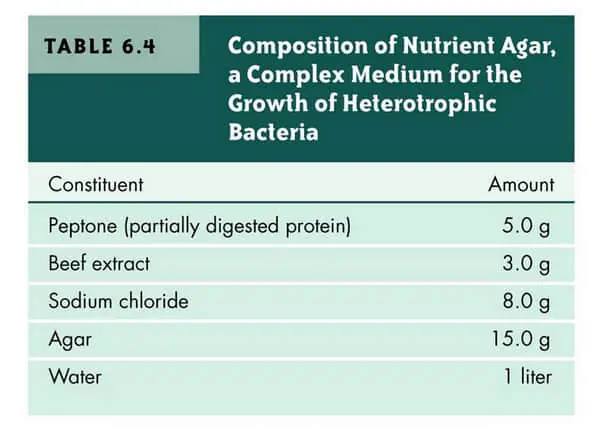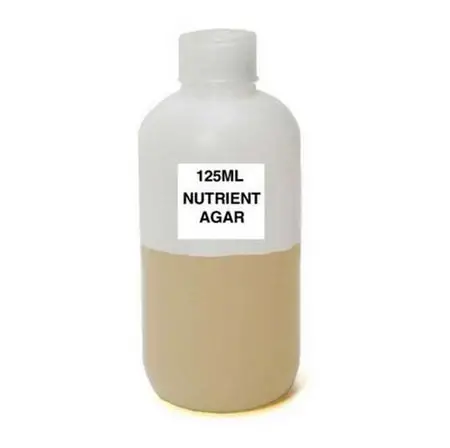A Growth Medium Consisting of Only Water, Glucose and Beef Extract Would Be Considered
Agar is a complex polysaccharide. It is highly valuable to microbiologists, although information technology provides no food support for bacteria. Information technology is ordinarily used in the laboratory setting primarily because of the following reasons:
- It remains solid and simply a few microbes can degrade it.
- It will remain solid until it reaches 100 degree Celsius. Once information technology is liquefied, information technology volition remain liquid until the temperature reaches 40 degree Celsius.
- Information technology has the power to remain solid even at a high temperature, which makes information technology perfect for growing estrus-loving bacteria. (1, 2, three, and 4)

Image 1: Four Petri dishes with nutrient agar used as a medium. Four types of bacteria are beingness tested for growth in nutrient agar.
Movie Source: wikimedia.org

Image 2: A Petri dish with a colony of Klebsiella on nutrient agar.
Moving picture Source: researchgate.internet
What is a Food agar?
It is a general purpose agar; specifically, a nutrient medium primarily used for cultivating microbes and support the growth of a huge array of not-selective organisms. It is the most popular type of agar considering of its ability to abound a variety of leaner and fungi. It contains the essential nutrients needed for growing bacteria.
Nutrient agar is a circuitous media. It is perfect for growing non-selective heterotrophic bacteria. Such bacteria cannot make their own food and are not selective when information technology comes to their food sources. Many disease-causing leaner are non-fastidious. Nutrient agar, beingness a complex media, is the ideal medium for growing and cultivating leaner. (3, 4, 5, and 6)

Prototype iii: The compositions of nutrient agar.
Picture Source: slideplayer.com

Image 4: Nutrient agar as a growth medium.
Film Source: bigcommerce.com
Components of Nutrient agar
- Beef extract – information technology is derived from tissues of lean beef (aqueous extract). It has water-soluble substances of creature tissues similar organic nitrogen compounds, salts, carbohydrates, and water-soluble vitamins.
- Peptone – information technology is an enzymatic assimilate of animal proteinaceous materials such every bit beast protein, casein, and gelatin using enzymes or acids. It is the main supply of organic nitrogen for growing bacteria. It may contain vitamins and carbohydrates.
- Agar – it is the solidifying agent.
- Sodium chloride – information technology is responsible for maintaining common salt concentration in the medium. It functions the aforementioned manner every bit the jail cell'southward cytoplasm.
- Distilled water – It is needed for the organisms to grow and reproduce. Through h2o, nutrients can be transported. (3, six, seven, and eight)
Note : pH is adjusted to neutral at 25 °C.
What are the uses of nutrient agar?
- It is used to isolate and purify cultures.
- Information technology is used as a ways for the production of bacterial lawns necessary for an antibiotic sensitivity test.
- It is used to cultivate and maintain non-captious microorganisms.
- Information technology aids in enumerating microorganisms in water, dairy products, sewage, feces, and other types of materials. (3, ix, and ten)
How to prepare the Food agar?
- Prepare about 28 grams of food agar powder. Suspend it in a liter of distilled water.
- Bring the mixture to rut making sure yous constantly stir the mixture to totally deliquesce all its components.
- Once the mixture is fully dissolved, the next step is to an autoclave for xv minutes at 121 degree Celsius.
- Once autoclave is consummate, permit the medium rest. The purpose is to cool it down and not solidify.
- Cascade the agar into the plate making sure you put the plate on a sterile surface. Leave it there until such time it solidifies.
- Put the lid of the Petri dish and place within the refrigerator. (ane, iv, seven, and 9)
Quality Control
- I of the important things to check is the color of the prepared nutrient agar. The expected color should exist light amber.
- The pH of the medium should be 6.viii ± 0.2.
- The performance of the media should be checked with the assistance of stable, typical control cultures. (3, 6, and 10)
Summary
Nutrient agar is used to cultivate a multifariousness of microorganisms. It is a full general purpose medium; a complex one and aids in the cultivation and growth of non-captious microorganisms. However, it is of import to note that nutrient agar is non used to diagnose diseases and other conditions in humans.
References
- https://en.wikipedia.org/wiki/Nutrient_agar
- https://microbiologyinfo.com/nutrient-agar-composition-preparation-and-uses/
- https://microbeonline.com/nutrient-agar-limerick-preparation-uses/
- https://microbiologyonline.org/teachers/training-of-media-and-cultures
- https://world wide web.homesciencetools.com/product/food-agar-sterile-125ml/
- https://sciencing.com/nutrient-agar-vs-claret-agar-6372699.html
- https://sciencing.com/chemical-composition-nutrient-agar-14135.html
- http://sciencestuff.com/nav/instructions/agar1.htm
- https://world wide web.thermofisher.com/gild/catalog/product/CM0003B
- https://microbenotes.com/nutrient-agar-principle-limerick-preparation-and-uses/
Source: https://laboratoryinfo.com/nutrient-agar/
0 Response to "A Growth Medium Consisting of Only Water, Glucose and Beef Extract Would Be Considered"
Post a Comment